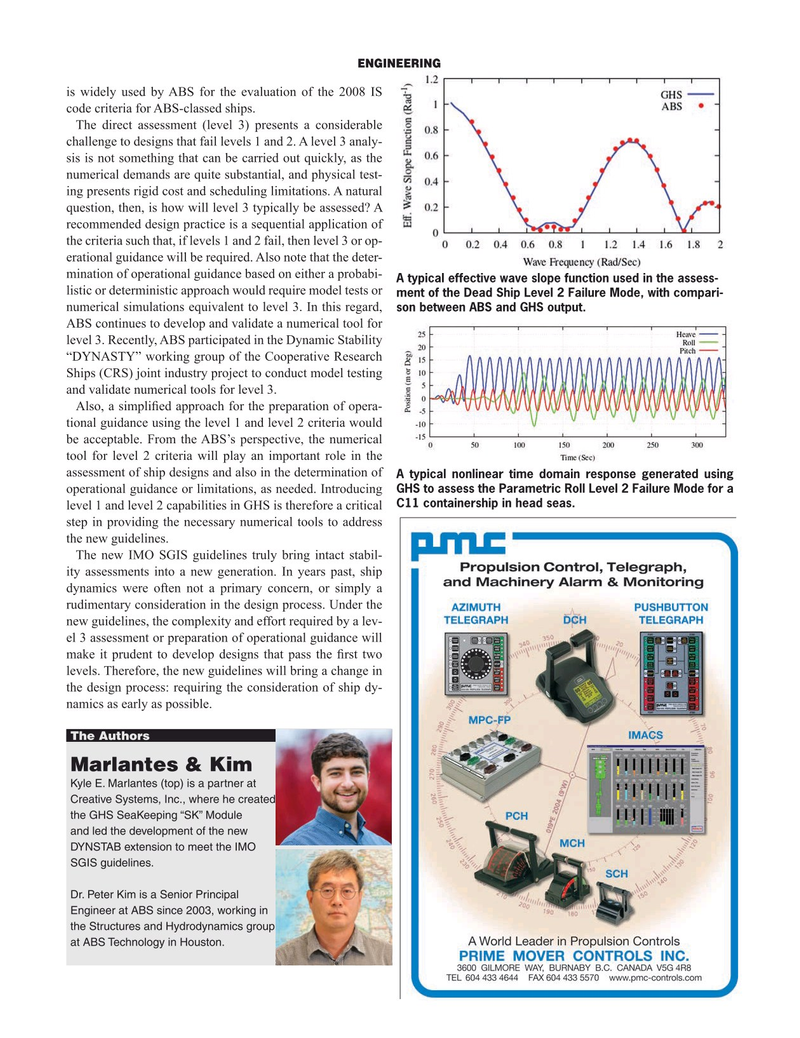
Page 53: of Maritime Reporter Magazine (November 2020)
Workboat Edition
Read this page in Pdf, Flash or Html5 edition of November 2020 Maritime Reporter Magazine
ENGINEERING is widely used by ABS for the evaluation of the 2008 IS code criteria for ABS-classed ships.
The direct assessment (level 3) presents a considerable challenge to designs that fail levels 1 and 2. A level 3 analy- sis is not something that can be carried out quickly, as the numerical demands are quite substantial, and physical test- ing presents rigid cost and scheduling limitations. A natural question, then, is how will level 3 typically be assessed? A recommended design practice is a sequential application of the criteria such that, if levels 1 and 2 fail, then level 3 or op- erational guidance will be required. Also note that the deter- mination of operational guidance based on either a probabi-
A typical effective wave slope function used in the assess- listic or deterministic approach would require model tests or ment of the Dead Ship Level 2 Failure Mode, with compari- numerical simulations equivalent to level 3. In this regard, son between ABS and GHS output.
ABS continues to develop and validate a numerical tool for level 3. Recently, ABS participated in the Dynamic Stability “DYNASTY” working group of the Cooperative Research
Ships (CRS) joint industry project to conduct model testing and validate numerical tools for level 3.
Also, a simpli? ed approach for the preparation of opera- tional guidance using the level 1 and level 2 criteria would be acceptable. From the ABS’s perspective, the numerical tool for level 2 criteria will play an important role in the assessment of ship designs and also in the determination of
A typical nonlinear time domain response generated using
GHS to assess the Parametric Roll Level 2 Failure Mode for a operational guidance or limitations, as needed. Introducing
C11 containership in head seas.
level 1 and level 2 capabilities in GHS is therefore a critical step in providing the necessary numerical tools to address the new guidelines.
The new IMO SGIS guidelines truly bring intact stabil- ity assessments into a new generation. In years past, ship dynamics were often not a primary concern, or simply a rudimentary consideration in the design process. Under the new guidelines, the complexity and effort required by a lev- el 3 assessment or preparation of operational guidance will make it prudent to develop designs that pass the ? rst two levels. Therefore, the new guidelines will bring a change in the design process: requiring the consideration of ship dy- namics as early as possible.
The Authors
Marlantes & Kim
Kyle E. Marlantes (top) is a partner at
Creative Systems, Inc., where he created the GHS SeaKeeping “SK” Module and led the development of the new
DYNSTAB extension to meet the IMO
SGIS guidelines.
Dr. Peter Kim is a Senior Principal
Engineer at ABS since 2003, working in the Structures and Hydrodynamics group at ABS Technology in Houston.
MR #11 (50-65).indd 53 11/9/2020 6:13:10 PM

 52
52

 54
54
